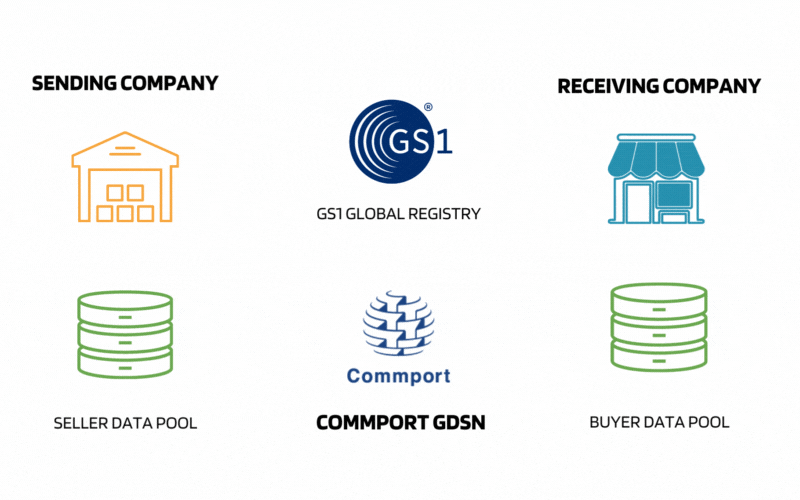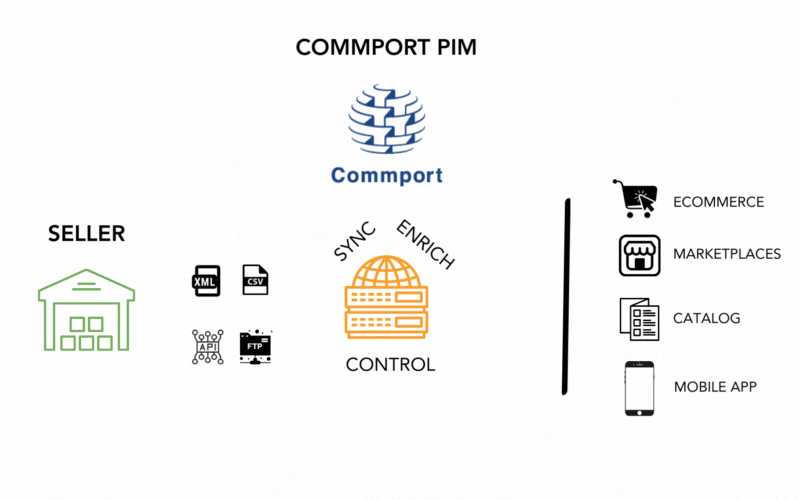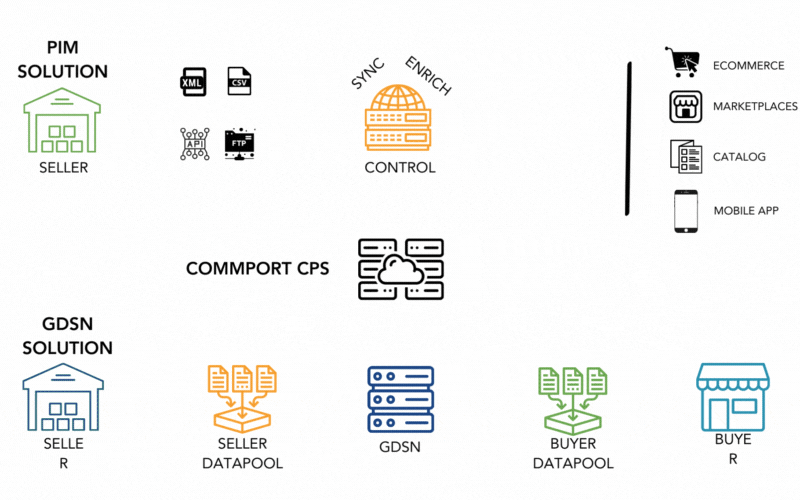Product content syndication is the process of distributing detailed and consistent product information across multiple channels and platforms. This ensures that accurate, up-to-date content is available wherever potential customers might encounter your products. Syndication typically involves sharing various types of content such as product descriptions, specifications, images, videos, reviews, and pricing information.

Welcome to the ultimate guide to product content syndication! This comprehensive guide will explore the power of syndicating your product content to boost your product presence and drive more sales.
Whether you are an e-commerce business, a retailer, or a manufacturer,
product content syndication can be a meaningful change in today’s competitive digital landscape.
So, what exactly is product content syndication?
It is distributing your product information, such as descriptions, images, and specifications, across various retail and online platforms. By getting your content in front of a wider audience, you can increase brand visibility, attract more buyers, and drive more sales.
But how do you effectively syndicate your product content?
That is what we will uncover in this guide. From identifying the right syndication partners/solutions to optimizing your product content to meet marketplace requirements, we will give you actionable strategies and best practices to make the most of this powerful product content syndication solution.
Join us as we dive deep into the world of product content syndication and discover how it can take your product reach to new heights. Get ready to supercharge your sales and leave your competitors in the dust!
In this chapter, we will go through the history of product content syndication
We will also cover the definition of product content syndication, and learn about its importance in the modern business world.
Then, in later chapters, we’ll cover how to choose the right PCS, its benefits, and future trends.

Product content syndication, a practice that involves the distribution of product information across various platforms and marketplaces, has evolved significantly over the years. Initially, this process was manual, labor-intensive, and prone to errors. Retailers and manufacturers would exchange product information via physical catalogs, faxes, and phone calls, leading to inconsistencies and inefficiencies.
The advent of the internet and digital technologies marked a turning point. The late 1990s and early 2000s saw the emergence of e-commerce, which necessitated a more streamlined and accurate way of sharing product data. Electronic Data Interchange (EDI) became a common method for businesses to exchange information electronically, reducing manual entry and errors.
With the rise of online marketplaces such as Amazon and eBay, the need for consistent and comprehensive product content grew. This gave birth to more sophisticated syndication tools and networks, such as the Global Data Synchronization Network (GDSN) and Product Information Management (PIM) systems. These technologies enabled businesses to automate and standardize the sharing of product data, ensuring that accurate and up-to-date information reached consumers regardless of the platform.
After 2016, the consumer buying pattern has changed significantly, in this new era of omnichannel strategy, product content syndication is crucial for businesses, where consumer behavior typically involves researching online before making a purchase online/offline based on convenience. The 2023 Global Consumer Insights Pulse Survey by PwC revealed that 55% of respondents use search engines to gather information about products and services, compare prices and brands, and read reviews. Amazon is the second most visited platform for this purpose, with 35% of researchers turning to it, while 29% visit websites dedicated to price comparisons. In summary, providing your audience with accurate, timely, and relevant information about your products and services online is essential in today’s market.
Product content syndication refers to the process of distributing detailed and consistent product information such as descriptions, images, specifications, and more across multiple sales channels, such as online marketplaces, retail websites, industry directories, and social media platforms. This includes data points like product descriptions, specifications, images, prices, and availability.
The importance of product content syndication cannot be overstated. In today’s competitive e-commerce landscape, consumers expect accurate and comprehensive product information to make informed purchasing decisions. Inconsistent or incomplete product data can lead to lost sales, increased returns, and damage to brand reputation.
Effective product content syndication involves more than just sharing your product data. It also includes optimizing the content, ensuring it aligns with the specific requirements and guidelines of each syndication partner, and monitoring the performance of your syndicated content to make data-driven improvements. By taking a strategic and initiative-taking approach to product content syndication, businesses can unlock a powerful marketing channel to drive visibility, engagement, and sales.
Let us play out a scenario,
A big fashion brand wants to expand its presence. They decided to sell on 6 more sales platforms so basically what that means is all the product content information the company has on its website / retail stores should be transferred to the new channels. However, each platform may have a unique set of standards and requirements, this becomes a huge challenge. This is where product content syndication solutions like Commport CPS come into play, which can not only help you with product data feed creation as per the requirements of each channel but also help with syndication and push new product updates as and when it’s added in real-time.
Another reason product content syndication has become so important is because in this digital era consumer shopping behavior has changed significantly because of the growing demand for omnichannel experience. Consumers conduct pre-purchase online research, and they cannot rely on their senses—such as touch, taste, or smell—to evaluate the goods or services they are considering buying. Instead, they depend on rich product content like how-to videos, 360° images, and detailed product specifications to inform their decisions. Product content syndication ensures that this information is accurate, consistent, and available on the platforms and sites they visit most frequently.
With the increased number of consumers turning to the internet to research and purchase products online or offline by visiting the physical store, businesses need to ensure that their products are easily accessible and discoverable across all channels. By syndicating your product content to all your marketplaces, you can tap into a vast pool of potential customers and increase the chances of your products being found and purchased.
It comprises of three essential elements,
This included product names, prices, descriptions, functions, competitive advantage, and anything else that could help customers decide.
Highly quality pictures taken from different angles, 360 product videos, close-up shots, any supporting infographics, tutorials, and more.
It includes extracting data from the content services provider (CPS).
While often used interchangeably, product content syndication and product data syndication have distinct differences. Product content syndication focuses on distributing detailed product information, including descriptions, images, and specifications, to enhance the consumer’s shopping experience. It is about making sure that all content related to a product is consistent across all channels.
Product data syndication, on the other hand, encompasses a broader scope. It includes all data related to a product, not just the content visible to consumers. This can involve logistical information such as inventory levels, pricing data, and supply chain details. Product data syndication ensures that all aspects of a product’s data are harmonized across different systems and partners, facilitating better management and operational efficiency.
In this chapter, we will go through information related to
How to Syndicate Product Content to Multiple Marketplaces?
We will also cover the list of marketplaces where you can sync your product data to.

The simple answer is to send your product information to wherever or whoever needs it. Depending on your retail partners and where you sell your products, the destinations for your product information will vary.
Here are the most usual places or people businesses syndicate to:
Syndicating product content to multiple marketplaces involves several key steps to ensure that your product information is accurate, consistent, and effectively reaches your target audience. Here is a detailed guide on how to achieve this:
Centralize Your Product Information: The first step is to gather all your product data into a single repository. This could be a PIM system, which centralizes product content, making it easier to manage and distribute.
Standardize Product Data: Ensure that your product data adheres to standardized formats required by various marketplaces. This includes standardizing product descriptions, images, and specifications.
Choose the Right Syndication Tools: Select appropriate syndication tools or platforms that support the marketplaces you wish to target. These tools should be capable of transforming your product data into the required formats for each marketplace.
Automate the Syndication Process: Automation is key to efficient product content syndication. Use tools that automate the data distribution process, reducing manual effort and minimizing errors.
Monitor and Update Product Data: Continuously monitor your product listings across different marketplaces to ensure data accuracy. Update product information regularly to reflect changes in inventory, pricing, and product details.
Compliance with Marketplace Requirements: Each marketplace may have specific requirements for product data. Ensure compliance with these requirements to avoid listing errors and potential penalties.
Before deciding on the right product content syndication solution first, you need to identify if your business needs one. Here are the 10 questions you need to ask yourself,
If you have answered ‘yes’ to any of these questions, then you need to start looking for the product content syndication solution.
In this chapter, we will be explaining
Choosing the right product content syndication solution is critical for maximizing the benefits
Best practices for successful product content syndication
There are many ways you can syndicate your product content and each one has its unique process, here are the top 4,
Manual syndication
This is the most time-consuming process and is prone to data entry errors. The product data is added to a spreadsheet and then emailed to the required partners. This method will not suit if you have hundreds of SKUs.
Product feed URLs
In this method, a live product link is created which contains all the product information and this link is created using spreadsheet data with the help of a PIM solution or feed management solution (FMS).
Product feed files
The difference between the feed URLs and deed files is in the name. As the name says the feed file is used for certain sales channels like Amazon, eBay, and more which do not take feed URLs. The method used to generate a feed file is the same as feed URLs.
Direct integration
Direct integration is achieved using plugins or APIs sometimes both together. Some PIM or feed management solutions have direct integration to all major marketplaces. So, it is important to choose the right PIM or product syndication solution that meets all of your trading partner’s requirements.
Automation is essential for effective product content syndication.
The Global Data Synchronization Network (GDSN) and Product Information Management (PIM) systems are both crucial for automating effective product data management and syndication, but they serve different purposes:
Lets explore the difference between GDSN and PIM,
The GDSN is a network of interoperable data pools that enables the real-time exchange of standardized product information between trading partners. It ensures that all participants have access to the same, up-to-date product data, facilitating global commerce and supply chain efficiency.
A PIM system is a centralized platform used by businesses to manage and distribute product information. It focuses on enriching product data, ensuring consistency, and distributing this information to various sales channels. While GDSN is about synchronizing data across different entities, PIM is about managing and enriching product data within an organization.
Choosing the right product content syndication solution is critical for maximizing the benefits and ensuring effective data management. Here are some factors to consider:
Compatibility: Ensure that the solution is compatible with your existing systems and the marketplaces you wish to target. It should seamlessly integrate with your PIM, ERP, and other relevant systems.
Scalability: Choose a solution that can scale your business. As your product catalog grows and you expand to new marketplaces, the solution should be able to manage increased data volume and complexity.
Automation Capabilities: Look for a solution that offers robust automation features. This includes automated data transformation, distribution, and real-time updates to ensure that your product information is always accurate and up to date.
Data Quality and Enrichment: The solution should provide tools for data quality management and enrichment. This includes validating product data, ensuring compliance with marketplace requirements, and enhancing product content with rich descriptions, images, and other attributes.
User-Friendly Interface: A user-friendly interface is essential for efficient data management. The solution should be easy to use, with intuitive navigation and clear workflows.
Support and Training: Choose a provider that offers comprehensive support and training. This ensures that your team can effectively use the solution and resolve any issues that arise quickly.
Cost: Consider the total cost of ownership, including licensing fees, implementation costs, and ongoing maintenance. Choose a solution that offers excellent value for money and aligns with your budget.
Achieving success with product content syndication requires a strategic and well-executed approach. Here are some best practices to help you maximize the impact of your syndication efforts:
Establish a centralized product data management system: Invest in a robust product information management (PIM) system or content management platform like GDSN that allows you to store, organize, and distribute your product data efficiently. This will streamline the syndication process and ensure consistency across all your product listings.
Optimize product content: Conduct thorough keyword research to identify the terms and phrases that your target audience is using to search for products like yours. Incorporate these keywords strategically into your product titles, descriptions, and other metadata to improve visibility in search engine results.
Ensure data accuracy and consistency: Regularly audit and update your product content to ensure accuracy and consistency across all syndication channels. Inaccurate or inconsistent product information can lead to customer confusion and frustration, damaging your brand reputation.
Prioritize high-quality, visually appealing content: As mentioned earlier, compelling visuals and multimedia content can significantly enhance the effectiveness of your product content syndication. Invest in professional-grade product photography and videos to make your offerings stand out.
Leverage customer reviews and social proof: Incorporate customer reviews, ratings, and testimonials into your product content to build trust and credibility. This social proof can be a powerful tool in influencing purchasing decisions and can help set your products apart from the competition.
Continuously monitor and optimize: Regularly track the performance of your syndicated product content across different channels. Analyze metrics such as click-through rates, conversion rates, and sales data to identify areas for improvement and make data-driven optimizations to your content and syndication strategy.
Collaborate with your syndication partners: Establish open communication and collaboration with your syndication partners. Understand their specific requirements, guidelines, and best practices, and collaborate closely with them to ensure your product content is presented in the most effective possible.
Stay up to date with industry trends and changes: Keep a close eye on the evolving landscape of product content syndication, including changes in platform policies, emerging trends, and new syndication opportunities. Continuously adapt your strategy to stay ahead of the curve and maintain a competitive edge.
While product content syndication can be a powerful marketing strategy, it is not without its challenges. Here are some common hurdles businesses may face and effective strategies to overcome them:
Here are some of the important benefits of product syndication solution
Improved data accuracy
Enhanced customer experience
Increased sales and more
Product content syndication offers numerous benefits to manufacturers, suppliers, and retailers, enhancing various aspects of their operations. Here are some key benefits:
Improved Data Accuracy: Syndicating product content ensures that all sales channels have access to accurate and up-to-date product information. This reduces the risk of errors and inconsistencies, improving the overall customer experience.
Enhanced Customer Experience: Consumers expect detailed and consistent product information when shopping online. Syndicating product content ensures that customers receive comprehensive and accurate information, leading to increased satisfaction and trust.
Increased Sales and Conversions: Accurate and detailed product information can significantly impact purchasing decisions. By providing consistent product data across all channels, businesses can increase sales and conversion rates.
Streamlined Operations: Automating the syndication process reduces the manual effort required to update product information across multiple platforms. This streamlines operations, saving time and resources.
Regulatory Compliance: Many industries have specific regulatory requirements for product information. Syndicating product content ensures compliance with these regulations, avoiding potential fines and penalties.
Better Supply Chain Management: Consistent and accurate product data enhances supply chain management by providing real-time visibility into inventory levels, pricing, and product details.
Manufacturers: Product content syndication helps manufacturers maintain control over their brand and product information across various sales channels. It ensures that their products are accurately represented, enhancing brand reputation and customer trust.
Suppliers: For suppliers, product content syndication streamlines the process of sharing product information with multiple retailers. This reduces manual data entry, minimizes errors, and speeds up the time-to-market for new products.
Retailers: Retailers benefit from receiving accurate and consistent product information from suppliers. This enhances the quality of product listings, improves the shopping experience, and reduces the likelihood of returns due to inaccurate product data.
In this chapter, we will be explaining
3 different Commport datapool solutions,
Commport’s product syndication solution offers a robust platform for automating and streamlining the syndication of product content.
Commport offers 3 different product content syndication solutions which are,

Commports GDSN (Global Data Synchronization Network) is a robust electronic solution designed to facilitate accurate and consistent exchange of product information among businesses. GDSN standards have been developed by GS1, a globally recognized standards organization, GDSN offers a standardized platform that enhances collaboration and operational efficiency among trading partners within the supply chain. GDSN is a powerful electronic solution that empowers businesses to streamline their supply chain operations, reduce errors, and improve collaboration among trading partners. By facilitating the exchange of accurate and standardized product information, GDSN enhances transparency, operational efficiency, and compliance throughout the global supply chain ecosystem. Leveraging GDSN enables businesses to optimize their supply chain.

Commport PIM (Product Information Management) is a robust software platform that centralizes and manages product data across an organization. It provides an only source of truth for product information, enabling businesses to efficiently create, enrich, and distribute consistent and accurate product data across multiple channels. Our innovative PIM solution is your gateway to perfect product management. Adopting Commport PIM enables businesses to streamline product data management, stay competitive in the market, and deliver consistent and compelling product experiences to their customers. Say farewell to the days of scattered data, inconsistencies, and missed opportunities. With Commport PIM, you can unlock the full potential of your product portfolio.

Commport CPS (Commport Product Syndication) is a Data Syndication Solution that combines GDSN (Global Data Synchronization Network) and PIM (Product Information Management) technology to enable businesses to efficiently manage and distribute product data across multiple channels. PIM solutions concentrate on centralized product information management, enrichment, and channel distribution within an organization. Whereas GDSN emphasizes the synchronization and exchange of standardized product information between trading partners, promoting consistency and accuracy across the supply chain. Depending on the specific needs and requirements of a business, they may choose to implement either PIM, GDSN, or both to effectively manage and exchange product information.
Assess Your Needs: Begin by assessing your current product data management processes and identifying areas for improvement. Determine the specific requirements for your business and the marketplaces you wish to target.
Onboard Your Data: Gather and onboard your product data into the Commport solution. This involves importing product information from your existing systems, ensuring data accuracy, and standardizing formats.
Configure the Solution: Our team will help you configure the Commport solution to match your business needs. This includes setting up data transformation rules, defining syndication workflows, and integrating with your target marketplaces.
Automate Syndication: Leverage Commport’s automation features to streamline the syndication process. Set up automated updates and real-time synchronization to ensure that your product information is always accurate and up to date across all channels.
Monitor and Optimize: Continuously monitor the performance of your product listings and optimize your syndication processes. Use analytics and reporting tools to gain insights into data accuracy, listing performance, and customer engagement.
Training and Support: Take advantage of Commport’s training and support resources to ensure that your team is fully equipped to use the solution effectively. This includes training sessions, documentation, and access to a resolute support team.
In this chapter, we will learn about retailer requirements
Future trends of Commport product syndication solution.
Retailer requirements for product content are constantly evolving, driven by changes in consumer behavior, regulatory standards, and technological advancements. Here is how to keep up with these changing requirements:
Stay Informed: Keep abreast of the latest trends and changes in retailer requirements. Subscribe to industry newsletters, attend webinars, and participate in relevant forums and events.
Leverage Technology: Use advanced syndication tools and platforms that offer real-time updates and compliance features. These tools can automatically adapt to changing requirements, ensuring that your product data remains compliant.
Collaborate with Retailers: Maintain open communication with your retail partners. Understand their specific requirements and collaborate on ways to meet these needs effectively.
Regular Audits: Conduct regular audits of your product data and syndication processes. This helps identify any gaps or areas for improvement and ensures ongoing compliance with retailer standards.
The future of product content syndication looks promising, driven by advancements in technology and changing consumer expectations. Here are some key trends to watch:
AI and Machine Learning: AI and machine learning will play a significant role in automating and optimizing product content syndication. These technologies can enhance data quality, provide predictive insights, and personalize content for different channels and audiences.
Enhanced Personalization: As consumer expectations for personalized experiences grow, product content syndication will need to become more sophisticated. Future solutions will offer advanced personalization features, tailoring product information to individual consumer preferences.
Omnichannel Integration: The integration of product content across all sales channels will become even more seamless. Businesses will need to ensure that their product data is consistent and synchronized across online, offline, and mobile platforms.
Product content syndication is a critical component of modern commerce, enabling businesses to provide accurate and consistent product information across multiple channels. By leveraging advanced syndication solutions, businesses can enhance the customer experience, improve operational efficiency, and stay competitive in an evolving market.
Understanding the differences between product content syndication and product data syndication, choosing the right syndication tools, and staying informed about changing retailer requirements are essential steps for success. As technology continues to evolve, the future of product content syndication promises even greater opportunities for businesses to optimize their product data management and enhance their market presence.
By following the guidelines and strategies outlined in this article, businesses can effectively implement product content syndication and reap the numerous benefits it offers. Whether you are a manufacturer, supplier, or retailer, embracing product content syndication will be crucial for thriving in the digital age.
Automation streamlines syndication by automatically formatting and distributing product data to multiple channels, reducing manual errors, saving time, and ensuring data accuracy and consistency across platforms.
It enables faster product launches, improves search visibility, ensures consistent branding, and supports better analytics by maintaining accurate product data across all e-commerce platforms and marketplaces.
Key features to consider include scalability, real-time updates, multi-channel integration, customization options, ease of use, compliance support, and robust customer service to ensure seamless operations.
Common challenges include managing large volumes of data, meeting diverse formatting requirements for different channels, keeping data updated in real time, and ensuring data accuracy and compliance.
By ensuring consistent and accurate product information across all platforms, syndication reduces confusion, improves customer trust, and enhances the shopping experience, leading to higher satisfaction and conversion rates.